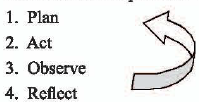UGC NET Paper1 Previous Year Solved Papers - 6th December 2019 Evening Shift
| Subject | Physics (200 max marks) | Chemistry (100 max marks) | Mathematics (200 max marks) | Computer science (200 max marks) | General English (100 max marks) |
| Marks Obtained | 155 | 80 | 165 | 140 | X |
- Option : C
- Explanation : Total maximum marks = 200+ 100+200 + 200 + 100= 800 Overall marks percentage = 78% Overall marks = 800 x (78/100) = 624 Total marks obtained = 155 + 80 + 165 + 140 + x = 540 + x Now, 540 + x = 624 x = 624-540 = 84
- Option : A
- Explanation : Intervention based action research is a
specific type of action research that adopts
a critical approach towards processes/
practices and aims for improvements. It
carries out the stages of planning, action,
observation and critical analysis or
reflection (based on collected data) on how
successful or unsuccessful the process of
research was and accordingly repeats the
cycle with improved plan and action in
order to introduce improvements in relevant
practices. This type of research is facilitated
by participation and collaboration of number
of individuals with a common purpose. The
recommended sequence is shown below.

- Option : B
- Explanation : Inference occupies a central place in the Hindu school of logic (Nyaya). This school worked out a syllogism in the form of an argument that goes through five stages: (1) the proposition (pratijna, literally "promise"), (2) the ground (hetu), (3) the illustration (udaharana), (4) the application (upanaya), and (5) the conclusion (nigamana). A syllogism is vitiated by a fallacious ground or hetvabhasa ("the mere appearance of a ground"). Upamana (analogy) is one of the six main sources of knowledge in astiks system of Indian philosophy.
- Option : A
- Explanation : Interpreting or analysing the collected data is essential to make inferences and arrive at conclusions. However, data should be in comprehensible form to be useful for the purpose. Qualitative data is generally descriptive and needs to be coded for ease of analysis. Qualitative data collected through technical media such as audio and/or video recording first needs to be transcribed (put thoughts, speech, or data into written or printed form), only then can it be coded. Data transcription refers to the process by which certain qualitative data is interpreted or translated into words that can then be categorised, coded and studied. Structural equation modeling is a multivariate statistical analysis technique that is used to analyze the structural relationship between measured variables and latent constructs. Sequential analysis or sequential hypothesis testing is statistical analysis where the sample size is not fixed in advance. Instead data are evaluated as they are collected, and further sampling is stopped in accordance with a pre-defined stopping rule as soon as significant results are observed. Sampling is the process of selecting units (e.g., people, organizations) from a population of interest so that by studying the sample the researcher may fairly generalize the findings to the population from which they were chosen.


